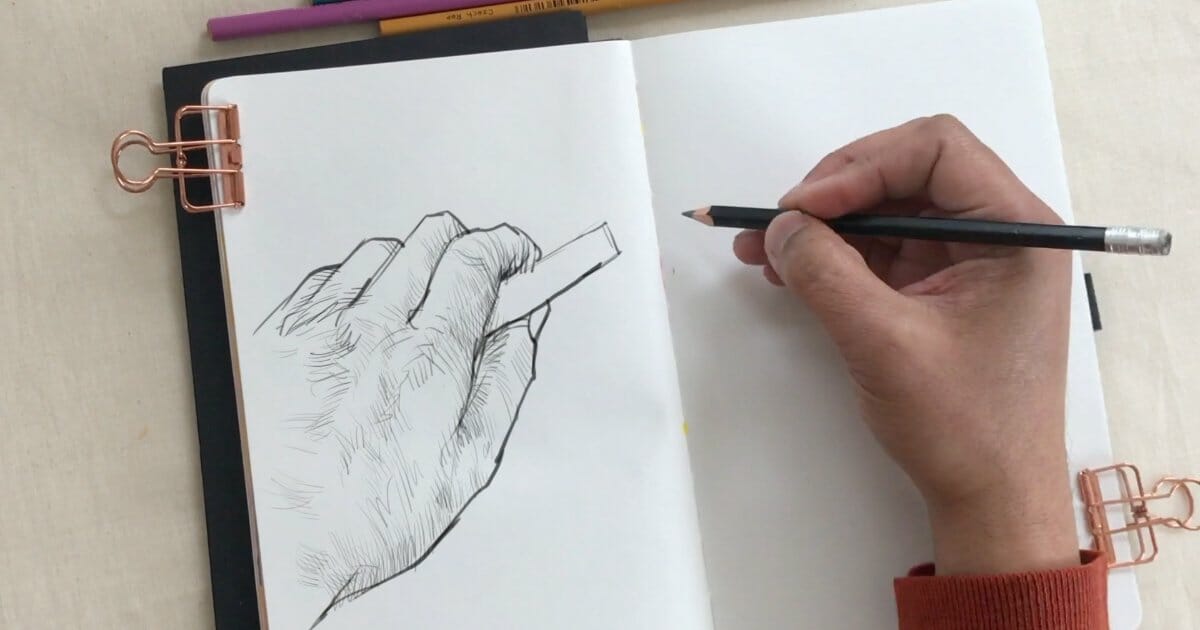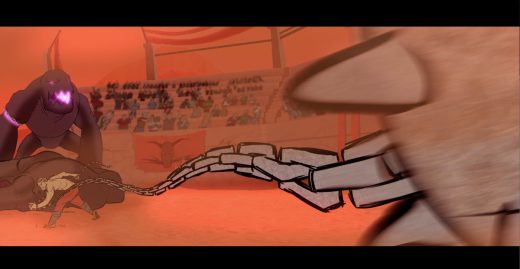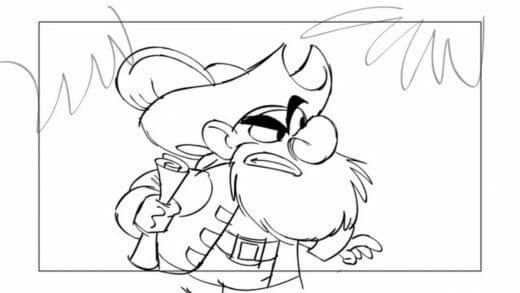
To show animators and independent artists possibilities for their work in Toon Boom Harmony 20, we invited seven artists and teams to produce a demo video, each contributing scenes inspired by a short prompt. These artists were drawn from both the Toon Boom Ambassador Program and our international community, and were given total creative freedom on their scenes.
Wahyu Ichwandardi, also known as Pinot, is a New York-based animator who works with pencil, pen, paper and pixel. Pinot built his following in the early days of Vine through hundreds of animated six-second videos and his work has since been featured by Esquire, The Washington Post, and the Tribeca Film Festival. In 2015, Twitter (Vine’s parent company) invited Pinot to the Cannes Lions festival to showcase his animation.
In the Harmony 20 demo video, Pinot’s scene shows a live-action right hand sketching its left counterpart, which then erases the hand that drew it. His scene makes use of filmed footage, rotoscopy and traditional animation. We spoke with Pinot about his career and animation process live on Twitch, and you can find highlights of our conversation below.
{% video_player “embed_player” overrideable=False, type=’scriptV4′, hide_playlist=True, viral_sharing=False, embed_button=False, autoplay=False, hidden_controls=False, loop=False, muted=False, width=’1920′, height=’1080′, player_id=’33072285237′, style=” %}
Pinot’s scene, inspired by the phrase, “Everyone can simply express their deepest dreams // Their truest stories.”
How would you describe your career in animation and the work you do?
My dad used to be an animator, but because the industry wasn’t mature enough in our home country, he’d teach animation at home with his kids. I started learning about hand drawn 2D animation, on paper. Along the way I graduated from college and became a motion graphic designer, a much more reachable profession for me at the time. I was a motion graphic designer for years, and then in 2013, I became an animator on social media.
Motion graphics was one of the options where I could still animate something with computers and software, but I still had a passion to create. Every picture had to move, change rotation and scale, and create a story. For me, motion graphics were a way of storytelling through moving pictures.
When Vine was released, it was another opportunity to go back to my childhood. I could make traditional 2D animation, even if it was just for fun at the beginning.
For our readers who might not remember, what was Vine?
Hopefully everyone still remembers Vine! It was one of the social video platforms in 2013, released by Twitter. It was unique for video platforms because you could only post 6-second videos and you could only post from your phone’s camera, not from a computer. You had to create in the app itself, so any animation or special effect couldn’t be made outside of the app.
It was like being a magician in a live performance on a stage. It took practice. It took so much preparation to create a six-second video. When you’re looking at my animation on Vine, it’s all essentially frame by frame.
There are some glitches here and there, but it’s okay because the story’s there and people already understand that it has to be made in the app’s camera. It gives a sense that humans make mistakes and we need to make peace with those mistakes. It’s part of the development and part of us as humans. Either we live with it or fix it going forward.
Animation + stop-motion + motion controlled camera.
Toon Boom Harmony + Dragonframe.pic.twitter.com/7mh2yB3qay— Pinot W. Ichwandardi (@pinot) May 12, 2017
How would you define your art style and what are your favourite subjects to draw?
I love to combine the real world and 2D animation. With that kind of animation, there’s a sense that anything you can imagine is doable. For me, there’s always something ordinary. I usually start with anything I can find in our daily lives, but in imagination it can become something other than paper and pencils.
I also want to give a sense that anyone can do animation — so long as they don’t have high expectations. Animation doesn’t have to be Disney-level animation. You can do it in a very simple way. You can animate with just one piece of paper and an eraser, drawing and erasing. I really hope that when people see animation, they’re not overwhelmed. I hope they think they can do it too.
I am not very crazy about the idea that animators are magicians. I usually get annoyed by people saying, “you’re a magician.” No, I’m not! Trust me, I am a live performer. I can only do magic to trick you.
The Harmony 20 demo video, what was the prompt that you were given and how did you interpret it for your scene?
My story was that animation is a tool which reaches between reality and imagination. You can draw and you can make imagination real with our surroundings. I previously explored a similar idea on Vine. I drew loops showing you can erase and draw, erase and draw.
The most challenging element wasn’t from a technical standpoint. The challenge was more coming from me, thinking about how things work and why. Asking myself why I am doing this kind of story and is it okay, is it doable, is it smooth enough? That kind of self-evaluation was one of the challenges I had. Like the drawing between my real hand and my drawn hand, I felt like I was fighting with my own hand.
I had to create something very simple but still convey a story. To be honest, I am a lazy animator.
Pinot, here’s why I don’t believe you are lazy: I saw that you built an entire multiplane camera setup out of LEGO with your children in your spare time.
Maybe the right word is not lazy? I am not a patient person. If someone gives me a task that I cannot put my heart into, I can’t do it. When I am doing that kind of video, I’m very happy to do it.
Cut 25 – a cut with ‘dolly cam’ (music by @diksat) pic.twitter.com/ckFThlx3XL
— Pinot W. Ichwandardi (@pinot) March 20, 2019
Were there tools in Toon Boom Harmony that you found particularly useful on your scene?
The one tool that really connects with me was the bitmap brush. There is so much software for generating automatic in-betweens from one frame to another, but the bitmap brush gives me the possibility to challenge myself.
I can become very perfectionistic, but most of the time I animate spontaneously, in the moment. I have to do it before the mood is gone and I am distracted by other things. When I am doing it right away, there is so much exploration. I have to keep myself on track — it has to be done for it to move and animate at the end. It’s a chaotic process.
Drawing frame-by-frame with a bitmap brush gives me a playground. If what I make is different from my original plan, sometimes I will have to make a new plan in the process. For me that’s the kind of tool I really need, it really matches with my style.
What are some of the challenges that can crop up when you work with animation and filmed footage?
Sometimes when I take the footage first and animate, I have to go back and shoot or reshoot, because my initial footage doesn’t match what I need. It can be a back-and-forth process. For me it’s an exploration — giving a chance for another idea to come.
Can I reshoot? Do I have to do a retake? Do I need to resize the frame because the hand is too big or the movement is too fast? Because it’s coming from me, I’m answering my own questions.
I also have to work in a very short time, because for personal projects the moment I am distracted — I might not continue until months later.
When do you sit down to animate your personal projects?
I usually need to be in a peaceful or playful state of mind. For me that’s the minutes before sleep, especially when my kids are going to sleep. I can be sitting at my desk with my pencil or mouse or tablet, and keep my mind wandering. Suddenly my kids are talking to themselves about a game or something very simple, and it gets my mind wandering. Sometimes they give me something that gives me a spark of an idea, and I can see it on the software or on paper without any plan.
Usually I animate right before bed, and I can sleep better afterwards.
Playing with @toonboom Harmony Advanced. Superlove the bitmap brush, gives more nature drawing style. pic.twitter.com/s8ZCWgKo1M
— Pinot W. Ichwandardi (@pinot) April 3, 2016
How do you tell stories in just six seconds?
My stories are always about three different steps, or three different sub-stories.
1) The opening: Tell viewers that something is about to happen.
2) The middle: A process that gives a sense that it will lead to something, but with an unknown outcome.
3) At the very end of the animation, a surprise.
Even in six seconds, you can tell that kind of story. An opening, a middle and a surprise. There always has to be a surprise.
Why do you think the projects you share online connect so well with audiences?
I think it’s because I don’t want to stick to one method or medium. I want to orchestrate the whole medium into one thing. I combine 2D animation with stop motion with a motion control device and multiple camera angles. It’s a process. Something happens in my head and people keep asking me why I do this, if I am a traditional animator or are you more of a digital animator? I can’t really answer that. I think I do a hybrid. I do stop motion and 2D animation, combining them.
Sometimes people think that I am not too crazy about technology, but I like to combine analog and the hi-tech together. It’s better when they’re connected together, so I can find new methods and stories.
Your work on Vine was featured at the Cannes Lions festival. What was that like?
It was a surreal moment at the time, because I never thought that my work could be appreciated that much around the world. I never won any kind of contest before in my life. Somehow when I learned that I won an award for my Vine, I took it as a sign that when i do work with my heart and patience without thinking too much about, I don’t know, appreciation? When I am working just for myself I can come up wide ideas I never thought of.
Someone from the future briefed an animator to create This Is America animation with Macintosh 512K, System 3.2 & VideoWorks software. Possible. pic.twitter.com/xUUUceZbiU
— Pinot W. Ichwandardi (@pinot) May 16, 2019
I have seen you post projects that you made using old Macintosh Computer, Palm Pilots, an old Nokia phone, and a Game Boy Camera. What draws you to classic hardware and what pushes you to push these technologies beyond their limits to make animation?
For me, that kind of device is like a personal journey back to when I was a kid in the 80s. When the Macintosh was released, I couldn’t afford that kind of machine, but the moment I saw it in my own eyes — how we create drawings, any creative process with that machine — it fascinated me. When I was a kid, my question to the people who used the Macintosh was “Can you create animation with it?”
They always had the kind of mindset that when you make animation it has to be like Disney animation. Full length with special effects. That kind of mindset makes people say that they cannot create that kind of animation with this machine, but as a kid I had so many questions. “Yeah, it’s possible but it’s not that good.”
For me, as long as we can create animation, it’s good enough. When I moved here, to the United States, I started digging on eBay, looking for the old Macintoshes. I’m just doing what I wanted to do back when I was a kid.
It is doable if we adjust our expectations. I can get animation from this machine, even if it’s only black and white, even though it’s not as smooth as state-of-the-art computer animation even in the 80s and 90s, but I can do it at my home and my kids can help me. I can do animation with a Nintendo Game Boy because it has a camera. I can do animation with a Palm Pilot because it has a stylus.
While other services have stepped in to replace it, do you miss Vine as a community and a platform for animation?
Yeah, I miss Vine as a community. At the time the social video platforms were already around for years — YouTube started in 2006, Vimeo and other social video platforms were on the iPhone before 2013 — but when Vine was released it was like everyone was looking in one direction, focused on one playground. Everyone was playing there, thinking, “I can be a comedian on this platform. I can be a video game reviewer.”
For the creative community, in stop motion and 2D animation, suddenly there was something to build more personal work into a platform. Not just for feature-length animation, but for social media. There was a possibility we never thought about before.
I really miss it as a community because it was like a giant collaboration for people doing the same thing. Now we have so many other alternatives scattered everywhere, so there’s no one focus. It’s different.
Do you have advice for animators who are interested in finding community online?
I think the best thing is to inspire other people outside the profession. Because now we are living with social media we can show something in the public space. So the audience itself is very broad. When we are doing something on social media, everyone’s looking at it. Give them the magic show they never expected. It doesn’t have to be very long. 30 seconds is too long.
On these platforms, you can be a one-person team. You can be the animator, producer, director, music creator. We are Instagrammers and TikTokkers. Being really small means the whole process can be embedded in one person. It’s doable.
Want to watch more of Pinot’s work? You can still see his 6-second animations archived on Vine, and be sure to follow him on Twitter, Instagram and YouTube for his most recent projects.



